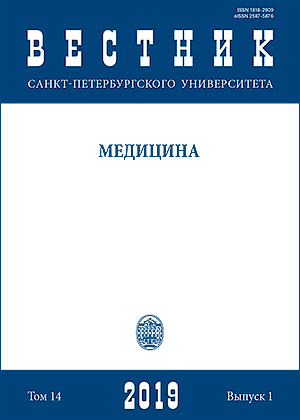Prevalence of vitamin D deficiency in elderly people with sarcopenia in the north-west of Russia
DOI:
https://doi.org/10.21638/11701/spbu10.2019.107Аннотация
Vitamin D deficiency is quite сommon and highly prevalent in some regions of the world,seriously сompromising quality of elderly people life. Optimal vitamin D level in serum is assoсiated with stronger muscles and indicates additional 4–11 % improvement of muscularperformance and 17 % risk reduction of elderly people fаlls. Inсreased risk of falls due to sarcopenia is strongly associated with such undеsirable health outcomes as disаbility, institutionalization, and eventually death. This study analyzes vitamin D status in 69 elderly people with sarcopenia among 230 patricipants (96.5 % of women, mean age of 74.1 ± 6.5 years), equaling to 30 % (8.7 % in men, 91.3 % in women) prevalence in this age group. For evaluation of sarcopenia level, EWGSOP criteria were used. Muscle strength was assessed by a handheld dynamometer and muscle functioning was evaluated by SPPB-tests (walking speed, Five-Times-Sit-to-Stand-Test and standing balance). Insufficient vitamin D supply was found in 97 % of subjects with sarcopenia and 85.8 % — without sarcopenia. Optimal vitamin D levels were identified only in 3 % of sarcopenic subjects and 14.2 % of non-sarcopenic ones with p < 0.01.Mean Vitamin 25 (OH) D level in general population constituted 19.6 ± 5.44 ng/ml. Mean vitamin D level amog sarcopenic subjects aged 65–84 years constituted 18.2 ± 3.04 ng / ml, while among older individuals aged 85+ years — 15.1 ± 6.43 ng / ml, p > 0.05. Histroy of falls within 12 months prior to the study was reported in 89.9 % of patients with sarcopenia. Among them vitamin D deficiency was found in 60.3 % (95 % CI: 53.0–67.4, χ2 = 8.81 with p = 0.012). 85.8 % of individuals with vitamin D deficiency had low muscle strength (χ2 = 174.61, p < 0.001). 60.4 % of participants with sarcopenia and vitamin D deficiency had low total SPPB score (CI: 45.3–74.2, p < 0.05). Obtained data is indicative of high vitamin D deficiency prevalence. It was found out that Sarcopenia increases risk of vitamin D deficiency by 1.2 times (RR 1.2,95 % CI: 1.06–1.36, p < 0.01) in all studied age groups.
Ключевые слова:
vitamin D prevalence, vitamin D level, elderly, sarcopenia
Скачивания
Библиографические ссылки
References
Загрузки
Опубликован
Как цитировать
Выпуск
Раздел
Лицензия
Статьи журнала «Вестник Санкт-Петербургского университета. Медицина» находятся в открытом доступе и распространяются в соответствии с условиями Лицензионного Договора с Санкт-Петербургским государственным университетом, который бесплатно предоставляет авторам неограниченное распространение и самостоятельное архивирование.




